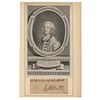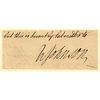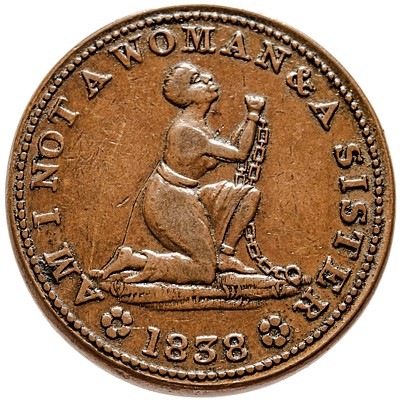SIR WILLIAM SAMUEL JOHNSON Cut Signature with 1766 Colonial Period Engraving
Lot 156
Categories
Estimate:
$400 - $500
Absentee vs Live bid
Two ways to bid:
- Leave a max absentee bid and the platform will bid on your behalf up to your maximum bid during the live auction.
- Bid live during the auction and your bids will be submitted real-time to the auctioneer.
Bid Increments
| Price | Bid Increment |
|---|---|
| $0 | $10 |
| $200 | $20 |
| $300 | $25 |
| $500 | $50 |
| $1,000 | $100 |
| $2,000 | $200 |
| $3,000 | $250 |
| $5,000 | $500 |
| $10,000 | $1,000 |
| $20,000 | $2,000 |
| $30,000 | $2,500 |
| $50,000 | $5,000 |
| $100,000 | $10,000 |
| $200,000 | $20,000 |
| $300,000 | $25,000 |
| $500,000 | $50,000 |
About Auction
By Early American History Auctions
Feb 27, 2021
Set Reminder
2021-02-27 12:00:00
2021-02-27 12:00:00
America/New_York
Bidsquare
Bidsquare : Black History & Slavery, Historic Autographs, Colonial America & Weapons
https://www.bidsquare.com/auctions/early-american-history-auctions/black-history-slavery-historic-autographs-colonial-america-weapons-6434
318 Lots of Rare, Historic Autographs, Americana, Civil War Era, George Washington, Abraham Lincoln, Slavery & Black History, Revolutionary War Era, Colonial America, Federal Period, War of 1812, Colonial Currency, Historic Early American Guns & more... Early American History Auctions auctions@earlyamerican.com
318 Lots of Rare, Historic Autographs, Americana, Civil War Era, George Washington, Abraham Lincoln, Slavery & Black History, Revolutionary War Era, Colonial America, Federal Period, War of 1812, Colonial Currency, Historic Early American Guns & more... Early American History Auctions auctions@earlyamerican.com
- Lot Description
Autographs
Sir William Samuel Johnson Cut Signature with Engraving
SIR WILLIAM SAMUEL JOHNSON (ca. 1715 - 1774). Important British Indian Agent in Colonial America.
Nice Bold clear example Cut Signature, "W. Johnson" likely as British Indian Agent in Colonial America, Choice Very Fine. Cut signature measured about 3" x 1 3/8" and is mounted to a larger 1766 dated handsome Engraved Portrait from London Magazine, measuring 5 " x 8" overall. Johnson settled in the Mohawk Valley about 25 miles west of Schenectady, New York, where he established a trading post to serve the needs of white settlers and Native Americans. Johnson is noted for establishing strong relations with the native tribes, in particular the Mohawks. He learned their languages, dressed in their clothing, welcomed them into his home and labored to preserve their lands from encroachment. Johnson's diplomatic skills were put to work during King George's War (1744-48) when he enlisted Iroquois warriors in the war against France. He was also commissary of the store that equipped the Indians with munitions and other military supplies. He became the Superintendent of Indian Affairs, his role in persuading the Iroquois to stay out of Pontiac's Rebellion, and as lead negotiator in the first Treaty of Fort Stanwix, 1768, in which boundary disputes between the Iroquois and colonists were settled.
Sir William Johnson was born in 1715 in County Meath, Ireland, and immigrated to the American colonies in 1738 at the invitation of his uncle, Peter Warren, a prominent figure in the siege of Louisbourg. Johnson settled in the Mohawk Valley about 25 miles west of Schenectady, New York, where he established a trading post to serve the needs of white settlers and Native Americans. Johnson served as an agent for his uncle, assisting him in the management of extensive landholdings in the Mohawk Valley.
Johnson is noted for establishing strong relations with the native tribes, in particular the Mohawks. He learned their languages, dressed in their clothing, welcomed them into his home and labored to preserve their lands from encroachment. He also provided the natives with educational opportunities and religious instruction. Johnson's diplomatic skills were put to work during King George's War (1744-48) when he enlisted Iroquois warriors in the war against France. He was also commissary of the store that equipped the Indians with munitions and other military supplies. After this war he was commissioned as colonel of 14 companies of militia comprised of volunteers from colonial settlers and the Iroquois Indians. He was also appointed as the principle agent of New York Colony with the Iroquois Indians. He resigned from this post in 1751 when the colonial assembly discontinued funding the position. In 1754 he served as a delegate of the congress of seven colonies held at Albany.
The French and Indian War, 1755-1763, brought Johnson great prominence as a military leader and negotiator with the Six Nations. Despite the failure of Johnson's assault against Crown Point, he was successful as a military commander. In 1755 his troops defeated the French in the Battle of Lake George and subsequently erected Fort William Henry. His victorious campaign here was rewarded with a baronetcy. In 1756 Johnson was appointed the superintendent of all of the northern tribes, a position he held for the rest of his life. Johnson's forces again achieved great victory in battle in 1759 when they seized Fort Niagara, the key to the West. The following year he joined forces with Jeffery Amherst in routing French forces in the vicinity of Montreal. During the later years of the war, Johnson was in almost constant negotiation with the Six Nations and other natives. After the war, he won prominence by persuading the Iroquois to stay out of Pontiac's Rebellion. In 1768 Johnson was the lead negotiator in the first Treaty of Fort Stanwix in which boundaries were established between the lands of native peoples and colonists. The boundary dispute between the Mohawks and Mohicans was settled here, too. Later he helped resolve a disputed claim to land in the Ohio River Valley.
Johnson acquired huge land holdings, much of which came as gifts from the Mohawks, and he became one of the wealthiest men in the colonies. In 1762 Johnson founded the city of Johnstown, N.Y., and was successful in obtaining its designation as the county seat of Tryon County. He also had a large manor house erected on a massive estate near there that was known as Johnson Hall, a baronial manor frequented by many native visitors. He married, first, Catherine Wisenberg, who bore him three children. After her death, he married two successive Native American women. The second of these was Molly Brant, sister of the famed chief Joseph Brant. Johnson died at Johnson Hall in 1774 and is buried in Johnstown.
Our Auction Contents:
Black History & Slavery: (Lots 1 - 63)
Abraham Lincoln Related: (Lots 64 - 74)
Historic Autographs: (Lots 75 - 235)
Colonial America: (Lots 236 - 261)
Revolutionary War: (Lots 262 - 304)
George Washington Related: (Lots 305 - 306)
Early American Guns & Weapons: (Lots 307 - 318) - Shipping Info
-
Early American provides in-house worldwide shipping. Please contact us directly if you have questions about your specific shipping requirements.
-
- Buyer's Premium



 EUR
EUR CAD
CAD AUD
AUD GBP
GBP MXN
MXN HKD
HKD CNY
CNY MYR
MYR SEK
SEK SGD
SGD CHF
CHF THB
THB












